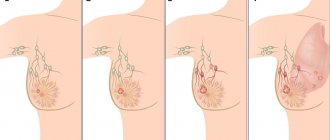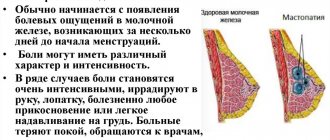Fibroadenoma is a benign pathology that occurs against the background of hormonal imbalance.
As a rule, the disease develops only in one gland, but bilateral damage is possible.
A tumor can grow at different rates, which depends on various factors. The danger of fibroadenoma is its possible transformation into oncology, which is observed in 10% of cases.
In most cases, the disease is diagnosed in women of childbearing age, but sometimes occurs during menopause.
The essence of pathology
In fact, fibroadenoma is a compaction with clear contours, which belongs to nodular mastopathy. Pathological growth of glandular and connective tissue is associated with endocrine disorders.
To prescribe the most optimal therapy, it is necessary to accurately determine the type of pathology:
- leaf-shaped;
- intracanalicular;
- pericanalicular;
- involutive.
NOTE!
It is impossible to independently assess the condition of the mammary gland, determine the type of fibroadenoma and its benignity. Therefore, if there are lumps in the mammary gland, consultation with a mammologist is necessary.
After a thorough diagnosis, the doctor will make an accurate diagnosis, which will be the basis for treatment.
As a rule, the treatment of fibroadenoma is surgical, but in some cases conservative treatment is allowed, which will inhibit the growth of the tumor and stop the clinical manifestations of the disease.
It is impossible to completely get rid of the pathology using medication.
https://youtu.be/tsKGBR3PVS8
When should fibroadenoma be removed?
Indications for surgical intervention are the following factors:
- the tumor grows quickly, and there is an increased risk of transformation of a benign pathology into a malignant one. This is especially true if the patient has a family history of cancer;
- pregnancy or planning it. Since significant hormonal changes occur in a woman’s body during pregnancy, the tumor can grow faster, which will lead to unpredictable consequences;
- deformation of the mammary gland. A growing fibroadenoma can create a visible cosmetic defect that negatively affects a woman’s quality of life;
- the patient's wish.
IMPORTANT!
It is extremely necessary to accurately determine the nature of the pathology, because the method of surgical intervention will depend on this.
What is this operation?
Sectoral resection is a surgical intervention during which not only the tumor itself is removed, but also the sector of the organ where the tumor is located.
A sector is a triangular zone that occupies 1/6 or 1/8 of the mammary gland. The sharp end of the sector is directed towards the nipple area. The tumor margin and the resection line must be separated by healthy tissue, since the visual and actual margin of the tumor may differ.
Sometimes sectoral resection is prescribed for early diagnosis of an oncological process - as statistics show, such an intervention does not particularly affect the prognosis of the disease, but significantly improves the patient’s quality of life due to the absence or minimization of changes in her appearance.
The surgical intervention is performed under general or local anesthesia.
Benefits of the procedure
The advantages of this surgical intervention are:
- safety;
- maintaining the same appearance of the mammary gland;
- removal of only affected tissue;
- the ability to conduct histological analysis during surgery. If it turns out that the tumor is malignant, the scope of the operation can be expanded - it is possible to remove more tissue.
Expert opinion
Shustova Olga Leonidovna
Obstetrician-gynecologist of the highest category
Sectoral resection can be used not only to treat fibroadenoma, but also as a diagnostic method to determine the nature of the tumor. This intervention is less traumatic than a complete resection of the mammary gland, which means the patient will not experience stress due to changes in her appearance. If we talk about the advantages of sectoral resection, it must be said that, unlike enucleation (removal of only the tumor itself), the risk of relapse after sectoral resection is significantly reduced. In addition, if necessary, surgical intervention can be more extensive.
Indications for and features of recovery after sectoral resection of the breast
For tumor diseases of the breast, removal of the tumor often becomes the most radical method of treatment. Sectoral resection of the mammary gland is carried out with the aim of eliminating neoplasms of the organ as sparingly as possible.
Such excision defines a surgical intervention in which a sector is removed - the breast area, a triangle directed from the base of the breast to the nipple, constituting at least a sixth of the organ. It is excised, capturing healthy tissue to prevent possible complications.
Resection is possible at the first diagnosed stages of breast cancer. This makes it possible to preserve a woman’s breasts as much as possible.
Modern methods of pain management allow intervention with local and general anesthesia. For control, preoperative determination of the excision zone under ultrasound is carried out.
Indications and contraindications for sectoral resection
Sectoral resection of the mammary gland is used for:
- mastopathy with the presence of nodes;
- internal duct papilloma;
- preliminary diagnosis of malignant tumors;
- fibroadenoma;
- lipoma localized in a narrow area of the gland;
- granuloma in gland tissue;
- cancer at an early stage;
- excision of areas of the breast that are impossible to restore purulent tissue.
For malignant breast tumors, it is possible to perform this type of surgery if:
- the size of the formation does not exceed 30 mm;
- the size of the gland allows you to excise large areas of it;
- metastases have not penetrated the lymph nodes;
- Postoperative anticancer therapy will be prescribed.
Advantages of sectoral resection:
- is a gentle operation;
- protects the appearance of the gland as much as possible;
- Only the pathological part is excised.
If histology during surgery shows the presence of pathological changes in the tissues, then it is possible to remove a larger sector of the gland.
- Resection is not performed if:
- a woman is pregnant and breastfeeding;
- malignant tumors larger than 30 mm;
- systemic diseases;
- rheumatoid diseases;
- venereal pathologies.
Preoperative preparation
If intervention is necessary, the doctor conducts a conversation with the patient in which he determines the need for surgery and the course of its implementation. The patient is explained the consequences and complications that may arise during the operation. In order to select the necessary anesthesia, control tests are carried out for allergies to drugs used for pain relief.
Control preoperative analytical examinations are carried out:
- general and biochemical blood test, hormone and HIV analysis;
A general blood test is required before the procedure. - general urine analysis;
- performing breast ultrasound;
- control visit to the gynecologist;
- consultation with a cardiologist.
Should be canceled before surgery;
- vitamin E:
- hormonal contraceptives;
- aspirin and drugs containing it;
- smoking and drinking alcohol.
Before the operation, the patient should take a bath and limit herself to a light breakfast.
Carrying out the operation
The choice of anesthesia during surgery is influenced by the location of the tumor. If it is palpable, then local anesthesia is used using novocaine and lidocaine. If education:
- can only be seen under ultrasound;
- the tumor is not palpable;
- allergies to anesthetics;
- general anesthesia is used.
Before the operation, the doctor, based on ultrasound and mammogram data, determines the incision lines on the skin with a marker;
The doctor, having determined that the anesthesia has begun to take effect, makes tissue dissections. A few centimeters away from the tumor, a deep incision is made to the pectoralis major muscle. The doctor controls the tumor with one hand, and cuts off the affected area with the other. Immediately after extraction, the tumor is sent for histological examination. After confirming the presence of cancer cells in the tissues, the doctor decides to completely excise the mammary gland.
After removing the affected area, the doctor stops the bleeding, applies layer-by-layer sutures - the fiber is sutured first, then the skin, then a cosmetic suture is applied.
To ensure lymph drainage, a drainage is placed, then the area is covered with a bandage.
Features of surgery for fibroadenoma
Although fibroadenoma is a benign tumor, it often tends to grow, compressing the breast tissue. Due to the high risk of transformation into cancer, a decision is almost always made to excise.
A feature of such tumors is their fairly large size. During resection, a large part of the gland tissue is excised; therefore, despite the reliability of the method, a repeated visit to the surgeon is required to perform gland plastic surgery.
An alternative method to sectoral excision is laser burning of fibroadenoma; the essence of this modern method is targeted destruction of the tumor. The surrounding tissues are preserved with this removal method.
The operation is low-traumatic, the cavity that appears after the operation is filled with healthy tissue, the process takes three months. The shape of the breast remains normal and not disturbed. The negative aspect of this technique is the impossibility of histological examination of the excised tissue. It is advisable, before such an intervention, to conduct a puncture to examine for the presence of pathological malignant cells
Possible postoperative complications
After sectoral resection, the following complications are possible:
- Hematoma due to a large amount of blood. To prevent complications, the affected area is opened and the cavity is cleaned;
- Inflammation of the sutures.
Antibiotics are prescribed for treatment. If the process has affected the deep tissues and the separation of pus begins, an opening of the skin area with a suture is used, the cavity is cleaned of pus and drainage is installed; Pain after the procedure - Pain can be felt for 1.5 - 2 months after resection, and this does not apply to complications. If the pain is too severe and prolonged, a worsening prognosis may be suspected and a re-examination may be performed.
Complications after sectoral resection are considered:
- breast deformation;
- the appearance of folds and depressions at the nipple;
- scar due to poor-quality sutures;
- infection in a postoperative wound;
- pain for a long time after surgery;
- bleeding from the suture.
With sectoral resection, the appearance of cosmetic defects is justified by saving the life and health of the patient.
Postoperative recovery
Sectoral resection of the mammary gland requires the patient to stay in the hospital for at least three days. The patient is prescribed antibiotics and painkillers. After a three-day period of inpatient treatment, she is discharged and the course of painkillers and antibiotics is continued. If the doctor believes that the patient’s condition requires observation in a hospital, then this is due to necessity.
Immediately before discharge, the surgeon examines the operating area, removes the drainage and reapplies a sterile dressing. Stitches must be removed no earlier than after 15 days
Woman's behavior after discharge
Upon discharge, each patient should receive from the doctor a postoperative rehabilitation plan based on the characteristics of her body. After surgery, a woman should regulate her diet by excluding from the menu:
- hot, spicy foods;
- fat meat;
- fried and smoked foods;
- fats of animal origin.
All patients are recommended to use non-hormonal measures to prevent pregnancy until rehabilitation. You should pay attention to hormonal levels. If there are deviations, the doctor should prescribe treatment.
The woman must fully comply with the doctor's recommendations before removing the stitches.
When breastfeeding, you should pay attention to pain. If they are too strong, you should consult a doctor.
Examination by a doctor is carried out at least once every three months after surgery if you are feeling normal.
Since tumor diseases of the breast are closely related to pathologies of the reproductive system and are their consequence (these are inflammatory processes in the pelvis, uterine fibroids, physiological cycle disorders, appendage cysts), postoperative rehabilitation should include:
- treatment of existing gynecological diseases;
- wearing specially selected underwear made from natural fabrics;
- hormone therapy;
- contraception;
- lactation control;
- visiting specialists for the prevention of existing diseases - a neurologist, therapist, infectious disease specialist;
- the use of antidepressant drugs, restoratives, vitamins, soothing herbs;
- if possible, mammoplasty.
Compliance with all doctor’s recommendations will allow women to quickly restore their health and prevent possible pathologies in the future.
Share it with your friends and they will definitely share something interesting and useful with you! It's very easy and fast, just click the button for the service you use most often:
Evgeniya 10.11 14:30
Better read what Elena Malysheva says about this. For several years I suffered from poor health - headaches and dizziness, weight problems, abdominal pain, nausea, constipation, weakness, loss of strength, weakness and depression. Endless tests, visits to doctors, diets, pills did not solve my problems. The doctors no longer knew what to do with me. BUT thanks to a simple recipe, headaches, gastrointestinal problems in the past, my weight has returned to normal and I feel HEALTHY, full of strength and energy!!! Now my attending physician is surprised how this is so. Here is a link to the article.
healthmatka.ru
Indications and preparation
Such an intervention is used if it is necessary to remove granulomas, intraductal papillomas, lipomas, fibroadenomas or oncological tumors.
Partial removal of the mammary gland for fibroadenoma is prescribed when the tumor size is more than 2 cm, as well as when the tumor is growing rapidly. This intervention is also prescribed if a woman wishes to give birth to a child and breastfeed in the future.
NOTE!
Leaf-shaped fibroadenoma is a direct indication for sectoral resection. This type of pathology has an increased risk of transformation into oncology, so surgical intervention should be performed as soon as possible.
Despite the fact that sectoral resection is a relatively quick and uncomplicated operation, it requires certain preparation. The patient should undergo a medical examination not only by a mammologist, but also by a gynecologist and endocrinologist. This is necessary to exclude the presence of contraindications for surgery.
A few weeks before the intervention, you must stop taking hormonal medications, as well as vitamins C and E.
You also need to exclude from your diet foods that are rich in these substances. You also need to give up alcohol and smoking.
The evening before the intervention, the patient should have a light dinner, and it is also recommended to take a bath with soothing herbs.
Preparing for surgery
Sectoral resection of the gland is a simple and quick procedure. But despite this, it requires special training. First of all, a woman undergoes a thorough medical examination by a gynecologist, mammologist and endocrinologist to exclude existing contraindications.
If the tests performed deviate from the norm, the patient must visit a therapist, who will explain what should be done to normalize the functioning of an organ with unsatisfactory performance. This is necessary to reduce the risk of complications in the postoperative period.
In addition, a woman must take a blood test to check for antibodies to hepatitis and the HIV virus. If the result is positive, the operation is postponed and special treatment is prescribed by a venereologist or infectious disease specialist.
Actions before surgery
Before the intervention, a woman should:
- Stop taking contraceptives (after consulting the gynecologist who prescribed them).
- Avoid taking vitamin E five days before surgery.
- After consulting a cardiologist, three days before surgery, avoid taking blood thinners such as Aspirin and Curantil. Otherwise, bleeding may begin during the operation.
- Completely eliminate alcohol and cigarettes, as they contribute to the deterioration of blood supply to the tissues in the gland and, in this case, it will take more time to recover after surgery.
- If the operation will be performed under general anesthesia, the last meal should be at least 6-7 hours before the operation, and water - 4 hours. This is necessary to reduce the risk of vomiting during surgery, which is very dangerous.
- When performing surgery using local anesthesia, you must stop eating and drinking 3-4 hours before surgery.
How is it carried out?
As a rule, such fibroadenoma removal is performed under local anesthesia.
General anesthesia is used if the patient wishes, as well as in the presence of an oncological tumor or benign pathology, which is visualized on ultrasound, but not determined by palpation - in this case, doctors will need more time to find the tumor and assess its exact size.
Before the operation, the doctor marks the lines of the proposed incisions with markers. This marking is carried out during an ultrasound examination, when the specialist accurately sees the location and size of the tumor.
After administering the anesthetic, the doctor makes abdominal incisions along the marker lines. These lines are curved because this makes it easier to push the skin and soft tissue apart. Having cut the tissue in the right place, the surgeon presses the tumor with his hand, separates healthy tissue and removes a sector of the mammary gland.
Then measures are taken to prevent internal bleeding. The incisions are sutured in layers. In order to avoid fluid accumulation, drainage is installed for several days. The operation takes from 30 to 50 minutes.
I. Benign tumors
Removal of fibroadenoma
Carrying out surgery to remove fibroadenoma requires preliminary preparation, during which the size of the tumor and its location are determined, and additional procedures are prescribed (at the discretion of the attending physician). You can receive all types of the above services at our clinic.
Next, based on the results obtained after the patient has completed the preparation stage, the attending physician makes a decision on the procedure for performing the operation. In particular, fibroadenoma removal can be carried out by:
• Using a laser. Exposure that does not require hospitalization of the patient. The procedure takes less than 60 minutes and is performed without anesthesia. The device only affects the affected tissue. No external changes in the breast are subsequently observed;
• Cryodestruction. The procedure is performed under local anesthesia. The doctor makes a small incision through which, using special equipment, the tumor is frozen. Within 12 months it completely disintegrates and ceases to be palpable. The advantage of this approach is the absence of scars;
• Radiofrequency removal. The tumor is separated from healthy tissue under the influence of a radiofrequency device. As a result of the manipulation, a mark of no more than 10 mm in size may remain.
In addition, doctors at the Taganka Breast Center are also ready to remove fibroadenoma through surgery in one of the following ways:
• Enucleation. In most cases, the operation is performed under local anesthesia. An incision is made above the tumor, in the armpit area or after the areola of the nipple. Only the neoplasm itself must be removed; body tissues are not affected;
• Sectoral resection. This technique is used if the fibroadenoma has reached a certain size, and for treatment it is necessary to remove not only the tumor itself, but also part of the breast tissue in contact with it. Doctors usually use general anesthesia. The consequence of such intervention is loss of breast shape and size. The solution to this issue can be a mammoplasty procedure, which is also performed in our clinic;
• Total resection. It is prescribed if the patient has a conglomerate of fibroadenomas, in case of a high growth rate of tumors, or if the tumor is suspected of being malignant. As a rule, the manipulation is performed under general anesthesia. The operation time is from 25 minutes to an hour. At the same time, you can also use the breast restoration service.
If you wish, you can speed up the process of resuming the body's functioning in a natural mode by using the services of specialists from the Breast Center on Taganka. We are ready to develop for you an individual rehabilitation course that will strengthen your immune system and return your body to its correct mode of operation.
If you still doubt the need for surgical intervention, use the “Doctor’s Second Opinion” program!
Gynecomastia removal
Gynecomastia is not the disease itself or its cause, but a consequence. Surgery is, of course, the best way to eliminate traces of pathology, but it is carried out only after completing a course of treatment.
At the Breast Center on Taganka, we are ready to offer you all types of services necessary to get rid of endocrine diseases, cancer or hormonal imbalances that have led to enlarged mammary glands.
The operation itself in our clinic will be performed using one of the following methods:
• Liposuction (for false gynecomastia). Fatty tissue in the area of the enlarged mammary gland must be removed. The choice of anesthesia (general or local) depends on the volume and complexity of the surgical procedure. Before the operation, the breast is photographed, markings are applied to the area of treatment, after which punctures are made in the area of the lateral surface of the chest. Through these punctures, a solution containing electrolytes, anesthetic and vasoconstrictor drugs is injected into the fat layer. Excess fat tissue is removed. The patient is put on special compression garments, which must be worn for three weeks. You can go home on the day of surgery. Traces from surgery disappear after approximately 2 weeks;
• Laser treatment. It is performed under local anesthesia. At the first stage, a small incision (1.5-2 mm) is made on the chest; at the second, a special surgical tube is inserted into the overgrown tissue, from which a laser beam emerges, dissolving glandular or fatty tissues and sealing damaged vessel walls. The resulting liquid is pumped out with a vacuum pump.
• Subcutaneous mastectomy with preservation of the areola from the lara-areolar approach. It is carried out in several stages, the main ones being: treatment of the operated area, administration of an anesthetic, resection of the halo area and removal of the tumor;
• Subcutaneous mastectomy from paraareolar access with liposuction. is carried out in several stages, the main ones being: treatment of the operated area, administration of an anesthetic, resection of the halo area and removal of the tumor;
• Endoscopic mastectomy (for small enlarged mammary glands). Small incisions are made in the armpit area. Surgical instruments and the endoscope itself are inserted through them. There are no scars, scars, or even bruises or hematomas.
It is worth noting that when choosing subcutaneous and endoscopic mastectomy, the average hospitalization period will be about 2 days. After surgery, you must wear special shapewear for 2-3 weeks. You will be able to start working in 5-7 days, and start playing sports in a month.
If you wish, you can speed up the recovery process after surgery by using the services of specialists from the Breast Center on Taganka. We are ready to develop for you an individual rehabilitation course that will strengthen your immune system and return your body to its correct mode of operation.
If you still doubt the need for surgical intervention, use the “Doctor’s Second Opinion” program!
Removal of a breast cyst
Removal of a breast cyst requires preliminary preparation, which consists of both diagnostic results and additional procedures (as prescribed by the doctor). You can comply with these conditions by contacting our specialists.
The removal procedure itself is a puncture of the mammary gland. A thin needle is inserted into the tumor under ultrasound guidance. The entire contents of the cyst are pumped out, its walls collapse and stick together, and the cavity itself closes. This approach is absolutely painless and reliable. In addition, it leaves no marks on the skin.
You can speed up the body’s recovery process after such an intervention, as well as eliminate the cause of the tumor and prevent the possibility of relapse by using the services of doctors at the Taganka Breast Center. We are ready to develop for you an individual rehabilitation course that will strengthen your immune system and return your body to its correct mode of operation.
If you still doubt the need for surgical intervention, use the “Doctor’s Second Opinion” program!
Removal of intraductal papilloma
Surgery to remove intraductal papilloma is carried out based on the results of diagnosis and additional preparation procedures prescribed by your attending physician.
All manipulations are performed under anesthesia, the choice of which is determined depending on the location of the papillomas and the area of tissue to be removed. The surgeon uses the method of central resection of the mammary gland: he makes an incision along the entire contour of the areola, crossing all the ducts behind the nipple. If structural changes in the tissue are detected, the doctor removes damaged areas and blood clots.
The average duration of the operation is about half an hour. The growths themselves are eliminated by electrocoagulation (using electric current) or laser.
Please note that during this surgical procedure, changes in the shape and volume of the breast may occur. You can restore its beauty with the help of mammoplasty.
You can speed up the process of recovery of the body after such an intervention, as well as eliminate the cause of the tumor and prevent the possibility of relapse by using the services of specialists from the Breast Center on Taganka. We are ready to develop for you an individual rehabilitation course that will strengthen your immune system and return your body to its correct mode of operation.
If you still doubt the need for surgical intervention, use the “Doctor’s Second Opinion” program!
Removal of mastopathy
Doctors at the Taganka Breast Center perform operations to remove any form of mastopathy:
- fibronodular;
- diffuse-nodular;
- cystic nodular.
Before the operation at our clinic, you will be asked to undergo all the necessary examinations, and will also be prescribed a unique course of preparation for the operation, which will be developed based on the results of the collected anamnesis.
The surgery itself is performed using anesthesia. The choice of general or local anesthesia is made only after taking into account the severity of the pathological process.
During the operation, the tumor is removed, as well as the surrounding breast tissue. This can be used:
• Sectoral resection. This technique is used if the tumor has reached a certain size, and for treatment it is necessary to remove not only it, but also part of the breast tissue in contact with it;
• Total resection. Prescribed for high growth rates of tumors or suspicion of their malignant nature.
In particularly severe cases, partial or complete mastopathy may also be offered.
The duration of surgical procedures is about 40 minutes.
If you want to restore the shape and volume of your breasts after surgery, you can use this one.
Note! With the cystic form of mastopathy, the probability of relapse is 10%. Take care of your health - contact our doctors to prepare an individual rehabilitation course! We will find and eliminate the cause of the disease, and also help your body recover quickly!
If you still doubt the need for surgical intervention, use the “Doctor’s Second Opinion” program!
Removal of breast lipoma
Specialists at the Breast Center in Taganak are ready to offer a full range of services for the diagnosis and treatment of breast lipoma. If surgical intervention is unavoidable, our specialists will create an individual course of preparation for the operation for you, as well as perform the operation itself using one of the following methods:
• Radio wave exposure. It is performed using a special device that “burns out” the tumor. The resulting crust dissolves in the body within a few days;
• Laser lipoma removal. The manipulation is performed as soon as possible under local anesthesia. Advantages – no traces or scars are left;
• Enucleation of lipoma (husking). A thin needle is inserted into the tumor. The entire contents of the lipoma are pumped out, its walls collapse and stick together, and the cavity itself closes. This approach is absolutely painless and reliable. In addition, it leaves no marks on the skin. As a rule, hospitalization of the patient in this case is not required;
• Sectoral resection of the mammary gland (if there is suspicion of malignancy of the lipoma). It is used if the tumor has reached a certain size, and for treatment it is necessary to remove not only it, but also part of the breast tissue in contact with it.
Please note that during sectoral resection, changes in the shape and volume of the breast may occur. You can restore her beauty with mammoplasty!
You can speed up the process of recovery of the body after surgery, as well as eliminate the cause of the tumor and prevent the possibility of relapse, by using the services of specialists from the Breast Center on Taganka. We are ready to develop for you an individual rehabilitation course that will strengthen your immune system and return your body to its correct mode of operation.
If you still doubt the need for surgical intervention, use the “Doctor’s Second Opinion” program!
How long is the recovery period?
After sectoral removal of fibroadenoma, the patient is usually discharged after 2-3 days. Postoperative care can last for two weeks or more, however, the operated patient may feel the effects of the intervention for no more than 10 days.
In order for the recovery period to proceed without complications, it is necessary:
- exclude salty, fatty and fried foods;
- eat foods rich in vitamin C;
- wear underwear made from natural fabrics that does not pinch the chest;
- rest more;
- control your weight, if you experience weight gain of more than 3 kg, internal edema may develop;
- Follow all doctor’s recommendations and take medications prescribed by him.
As for when the sutures are removed, they are removed on days 7-10, depending on individual tissue regeneration.
IMPORTANT!
You can shower on the second day after the stitches are removed. You need to wash the seam with baby soap, and then not wipe it, but blot it with gauze and treat it with alcohol.
Sectoral breast resection: photos, reviews, postoperative period, consequences
Women often go to doctors with suspicions of a lump in the breast. There are many neoplasms for which sectoral breast resection is indicated. This operation allows you to save the organ by removing only a small area of glandular tissue. When sectoral resection is performed, and what the consequences may be, it is worth considering in more detail.
Excision or sectoral resection?
The patient’s life may depend on timely treatment of tumors in the mammary gland. The woman is prescribed radiation therapy, chemotherapy, sectoral resection or mastectomy. Patients often ask whether it is possible not to remove the breast, but to cut out only the area with the tumor. But, unfortunately, this is not always possible.
Mastectomy (removal of the breast) is inevitable if the tumor occupies more than one quadrant of the breast, if it has not responded to radiation or chemotherapy, or if cancerous tissue remains after sectoral resection. But you can be sure that if the doctor sees the opportunity to save the breast, then you will be prescribed a sectoral resection of the breast, and not complete removal.
Indications for testing
Removal of a sector of the mammary gland may be prescribed when diagnosing benign and malignant formations. Benign tumors include:
- fibroadenoma;
- cyst;
- external and intraductal papilloma;
- mastopathy;
- lipoma and others.
Malignant tumors include:
- adenocarcinoma;
- carcinoma;
- Paget's cancer (tumor of the nipple and areola);
- sarcoma and other types.
Effective sectoral resection for cancer can be performed under the following conditions:
- the process is at an early stage;
- the tumor is localized in the upper outer quadrant;
- absence of metastases was confirmed;
- the size of the mammary gland is sufficient for the operation;
- It is possible to continue treatment with radiation therapy.
In addition, resection of the mammary gland, a sectoral operation, can be performed for chronic mastitis and other purulent processes.
What complications can there be?
The reaction of each organism to operations is individual. Some people forget about the intervention after a few days; for others, the rehabilitation process is delayed and complicated.
The most common complication is inflammation at the incision site. After sectoral resection of the mammary gland, the wound could become infected due to the use of non-sterile dressing material, poor skin preparation, or touching with dirty hands. To prevent inflammation and suppuration in the incision area, patients are prescribed antibiotics. If the purulent process does begin, then the wound is opened, treated and drainage is installed.
The next possible complication is the appearance of a lump in the mammary gland. Most often, the lump turns out to be an accumulation of blood. To make sure that it is a blood clot, the doctor prescribes an ultrasound and warns the patient against using heating pads or compresses. To eliminate the compaction (hematoma), the wound is opened, treated and drainage is installed.
After sectoral resection of the mammary gland is performed, the consequences can be felt for quite a long time. For example, the patient may feel pain from the growth of scar tissue for up to two months. Doctors do not consider these pains to be postoperative complications, but if there are frequent complaints, they are required to prescribe a mammogram or ultrasound to clarify the cause.
What other consequences could there be?
Even if the most gentle resection of the mammary gland is performed, sectoral surgery can lead to a change in the shape of the breast. In addition, unattractive, noticeable scars appear, which cause women a lot of anxiety. As a result of the removal of a sector of glandular tissue, a depression or fold may form at the nipple.
Many patients have a very difficult time coping with the loss of external attractiveness. Before the operation, they look at what a sectoral resection of the mammary gland looks like (photo), and as a result they get upset, lose their appetite and sleep. After surgery, some patients become depressed. This condition is dangerous because the woman loses interest in life and does not want to take care of her health anymore. But, after a conversation with an experienced doctor, every woman is able to understand that her life is more valuable than beautiful breasts.
How is the postoperative period going?
After the patient has undergone sectoral resection of the mammary gland, the postoperative period is observed in the hospital under the supervision of specialists. If the woman feels well and there are no complications, she can be discharged after 2-3 days. Before this, the doctor examines, treats and dresses the wound.
If necessary, the patient is prescribed painkillers. Antibiotics are taken for the prescribed period. Sutures are removed 7-10 days after resection.
How to carry out rehabilitation
The condition of the mammary glands directly depends on the overall health of the woman’s reproductive system. Most neoplasms arise against the background of inflammation of organs in the pelvis. Most often, a woman experiences endometrial hyperplasia, fibroids or uterine fibroids, an irregular monthly cycle, a cyst or infertility. In addition, neoplasms can arise due to pathologies of the thyroid gland or liver.
Postoperative rehabilitation is built for each patient according to an individual scheme, taking into account concomitant diseases. Most often the list of events includes:
- treatment of gynecological diseases;
- normalization of hormonal balance;
- selection of contraceptive methods;
- diet correction;
- taking vitamins;
- conducting consultations with relevant specialists.
If the patient is acutely experiencing a change in breast shape, then it is advisable to undergo a course of psychotherapy.
Is breast surgery possible after resection?
Often, after the surgical scar has completely healed, a woman realizes that she does not need plastic surgery. But, if the patient wants to recreate the appearance of the mammary gland, then after a while she can turn to a plastic surgeon.
The clinic can perform:
- implant installation procedure;
- breast reconstruction with tissue flap;
- breast reconstruction using a musculocutaneous area taken from the abdomen;
- reconstruction with a segment of the latissimus dorsi muscle;
- reconstruction with a flap of gluteal tissue.
Patient reviews of sectoral breast resection
Removal of benign tumors in the breast using surgery is called sectoral breast resection. Reviews from operated patients vary, since in each individual case, the outcome of the operation depends on numerous factors, including the individual characteristics of the patient’s body.
While some women recover quickly after breast resection, for others this process can result in a number of complications.
If there are instructions for carrying out such an operation, first of all you need to have a positive attitude, since there is no need for excitement and stress in this situation. To avoid possible complications, you need to carefully prepare for resection: pass all the necessary tests, take sedatives the day before the operation and follow the doctor’s recommendations after surgery.
As evidenced by patient reviews, in most cases, sectoral breast resection is successful, without complications. This operation helps preserve the woman’s health.
fb.ru
Other removal methods
Fibroadenoma can be removed using enucleation. The intervention consists of removing the neoplasm itself, which minimally injures the gland tissue and does not lead to loss of the ability to lactation.
Total resection is the complete removal of the mammary gland, which is rarely used to remove benign pathologies.
As for minimally invasive methods for removing fibroadenoma, we must say about laser removal, cryodestruction, as well as removal of pathology with high-frequency currents.
These procedures are aimed at removing only the tumor and do not affect healthy tissue. The advantages of such treatment are the absence of trauma, a quick recovery period and preservation of the functionality of the mammary gland.











